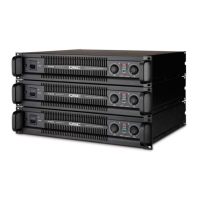PL3 Series Service Manual 39
TD-000274-00 Rev. A
Figure 3.8. Switching pulse at node N401 (pin 3 of U19)
When first checking the operation of an amplifier on the bench,
always turn your variable autoformer down to zero before plugging
the amplifier in.
After you turn the amplifier on, gradually turn up the AC voltage to
25% of full operating voltage (30 V for 120 V model, or 60 V for
230 V) as you observe the amplifier’s current draw and confirm that
its bias supply is working normally such as the power LED should
come on between 30 and 35 V (120 V model) or 60 to 70 V (230 V),
with its usual, steady “half-bright” start-up level; this will help you
determine what, if anything, is wrong with it.
If you see or smell smoke, flames, or any other signs of short circuits
or excessive current draw, quickly turn the AC voltage back down to
zero. If the LED comes on at 20 V (120 V model) or 40 V (230 V
model) or not until 50 V (120 V model) or 100 V (230 V model), or
blinks, do not raise voltage past 60 V (120 V model) or 120 V (230 V
model) until you have measured the bias supply voltage. If no such
problems occur, it is usually safe to turn the AC up to the amplifier’s
full operating voltage for further testing. Note: the switching will
not start until the AC voltage reaches above about 90 V (120 V
model) or 180 V (230 V model).
Power Supply Failure
The customer complains of blowing circuit breakers or fuses, or
burning smell or smoke or no power indicator.
Symptoms may include:
• Fuses blow immediately
• Line circuit breakers trip at turn-on
• The amplifier emits smoke
• The amplifier gives off a burning smell
• No power indicator or dim (half-bright)
Possible situations:
Blown IGBTs
Follow
Troubleshooting and Replacing Blown IGBTs
instructions to
restore the IGBTs and their control circuit. Before applying AC
voltage, verify the following:
• No drivers or output transistors are shorted. If you find any
damaged, see
Troubleshooting and Replacing Blown Output
Transistors
.
• No rectifiers—D72–D75, D80, D81, D84, and D85—are shorted.
Replace any that are damaged.
3.2 PL325 and PL340: Symptoms, causes, and remedies
• Perform a quick test of the bias supply as instructed in
Trouble-
shooting the TOP-210 Bias Supply Faults
.
Stays in protect; Power LED remains dim
Make sure that pin 2 (STBY) of the DataPort is not terminated to
ground by any device that might be plugged into the DataPort,
which would cause the amplifier to stick in standby mode.
Note: all measurements should be referenced to PRI_LO.
If node N408 (pin 1 of U13) is 0 V, check the following nodes:
• Node N446 (pin 6 of U13) should be 5 V. If not, check R338, R337,
and R336.
• Node N445 (pin 7 of U13) should be 8 V. If not, check R341, R342,
and L6. If these parts are okay, C124 may be leaking.
• Node N409 (pin 5 of U13) should be 8 V. If not, check R332, R325,
R326, R328, and C121.
• Node N418 (pin 9 of U13) should be 12 V. If not, check D58,
R323, R322, and R321. If these parts are okay, C107 or C108 may
be leaking.
• Node N410 (pin 8 of U13) should be 8.2 V. If not, check R325,
R326, and R328.
• Check Q94 for a possible shorted base-collector junction.
If node N408 (pin 1 of U13) is > 4 V, check the following nodes:
• Node N399 (pin 10 of U19) should be 0 V. If not, check U14:2.
• Node N401 (pin 3 of U19): 210–230 kHz (see Figure 3.8). If not,
check U14:1 and Q98.
• Nodes N397 and N398 (pins 11and 14 of U19): 105–115 kHz (see
Figure 3.9). If not, U19 or U18 is defective.

